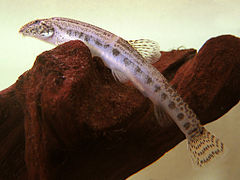- Spined loach
-
Spined Loach 
Conservation status Scientific classification Kingdom: Animalia Phylum: Chordata Class: Actinopterygii Order: Cypriniformes Family: Cobitidae Genus: Cobitis Species: C. taenia Binomial name Cobitis taenia
Linnaeus, 1758The Spined Loach (Cobitis taenia) is a common freshwater fish in Europe and Asia. It is sometimes known as spotted weather loach, not to be confused with the "typical" weather loaches of the genus Misgurnus. This is the type species of the spiny loach genus (Cobitis) and the true loach family (Cobitidae).
Contents
Description
The Spined Loach typically reaches an adult length of 8–10 cm, although females may grow up to 12 cm. Adults weigh between 20–60 g. Their backs feature a yellow-brown colouring interspersed with many small grey or brown scales on the spinal ridge. The scales on the belly are pale yellow or orange. The body overall is long and thin. There are 6 barbels around the mouth. Under the eyes there is a two-pointed spike, with which the fishes can inflict a painful sting.
Distribution and relationships
It is found from Siberia to Spain. Generally it occurs across much of temperate Eurasia north of the Alpide belt, with the exceptions of Ireland, Scotland, Wales and northern Scandinavia. Some population are also found just south of the Alpides, and at the eastern end of its range it reaches China.
Populations of southwestern Europe were formerly included in this species, but actually represent distinct branches of Cobitis. A member of subgenus Cobitis, close relatives of the Spined Loach are C. elongatoides, C. fahirae, C. tanaitica or C. vardarensis which replace it in northern Greece, much of Romania, and western Turkey.[1]
Ecology and behaviour
Clear oxygen-rich water is preferred by the spined loach, be it slowly flowing brooks, rivers or still water. They are found near flat and sandy or stony areas, frequently in large numbers. The spined loach is often kept as an ornamental fish in aquaria.
During the day, they bury themselves in the bed of the body of water, leaving only the head and tail exposed. At night, when the loach is most active, sand on the riverbed is consumed, and with it small animals and other organic material. Sand, stripped of nutrients, is ejected through the gills. This process must continue all night for the fish to get enough calories to survive.
Spined loaches possess the ability of intestinal breathing. This stop-gap measure sustains the spined loach when the water around it is oxygen-poor. At the water's surface swallowed air brings oxygen into the intestine. The expended air is expelled through the anus.
The spawning season is from April to June. The females produce between 300 and 1,500 eggs close to the ground: on stones, roots or plants. The eggs are then fertilized by the males. The larvae hatch in 4 to 6 days.
The spined loach's lifespan is between 3 and 5 years, with the maximum reached in captivity being 10 years.
See also
- Loach
Footnotes
- ^ Perdices et al. (2008)
References
- Froese, Rainer, and Daniel Pauly, eds. (2005). "Cobitis taenia" in FishBase. November 2005 version.
- "Cobitis taenia". Integrated Taxonomic Information System. http://www.itis.gov/servlet/SingleRpt/SingleRpt?search_topic=TSN&search_value=163981. Retrieved 19 March 2006.
- World Conservation Monitoring Centre (1996). Cobitis taenia. 2006. IUCN Red List of Threatened Species. IUCN 2006. www.iucnredlist.org. Retrieved on 12 May 2006.
- Perdices, Anabel; Bohlen, Jörg & Doadrio, Ignacio (2008): The molecular diversity of adriatic spined loaches (Teleostei, Cobitidae). Mol. Phylogenet. Evol. 46(1): 382–390. doi:10.1016/j.ympev.2007.05.007 (HTML abstract)
Categories:- IUCN Red List least concern species
- Cobitis
- Fish of Europe
- Fish of Asia
- Animals described in 1758
Wikimedia Foundation. 2010.

